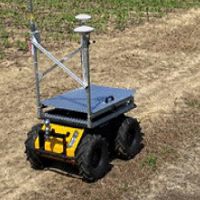Determining the utility of an unmanned ground vehicle for weed control in specialty crop systems

Accepted: 17 May 2021
HTML: 182
All claims expressed in this article are solely those of the authors and do not necessarily represent those of their affiliated organizations, or those of the publisher, the editors and the reviewers. Any product that may be evaluated in this article or claim that may be made by its manufacturer is not guaranteed or endorsed by the publisher.
Specialty crop herbicides are not a target for herbicide discovery programs, and many of these crops do not have access to relevant herbicides. High-value fruit and vegetable crops represent high potential liability in the case of herbicide-induced crop damage and low acres for revenue. Labour shortages and higher manual weeding costs are an issue for both conventional and organic specialty crop growers. Robotic weeders are promising new weed control tools for specialty crops because they are cheaper to develop and, with fewer environmental and human health risks, are less regulated than herbicides. However, many of the robotic weeders are too expensive for small growers to use. In the future, greater investment into robotic weeders for small-scale growers will be important. The Clearpath robotics platform Husky may provide a cheap and autonomous way to control weeds in small diversified specialty crop farms. Being able to work autonomously in multiple soil moisture environments is the driving factor behind optimizing the Husky platform for weed control. Research has been conducted to evaluate the impact of soil moisture and mechanical actuator on mobility and weed control. Though weed control was not commercially acceptable in these studies, future optimizations to the Husky robotics platform can achieve commercial success.
Highlights
- Specialty crop production is labor-intensive and vulnerable to rising labor expenses.
- Robotic weeders are promising weed control tools, with fewer environmental and human health risks.
How to Cite

This work is licensed under a Creative Commons Attribution-NonCommercial 4.0 International License.
PAGEPress has chosen to apply the Creative Commons Attribution NonCommercial 4.0 International License (CC BY-NC 4.0) to all manuscripts to be published.

 https://doi.org/10.4081/ija.2021.1865
https://doi.org/10.4081/ija.2021.1865







